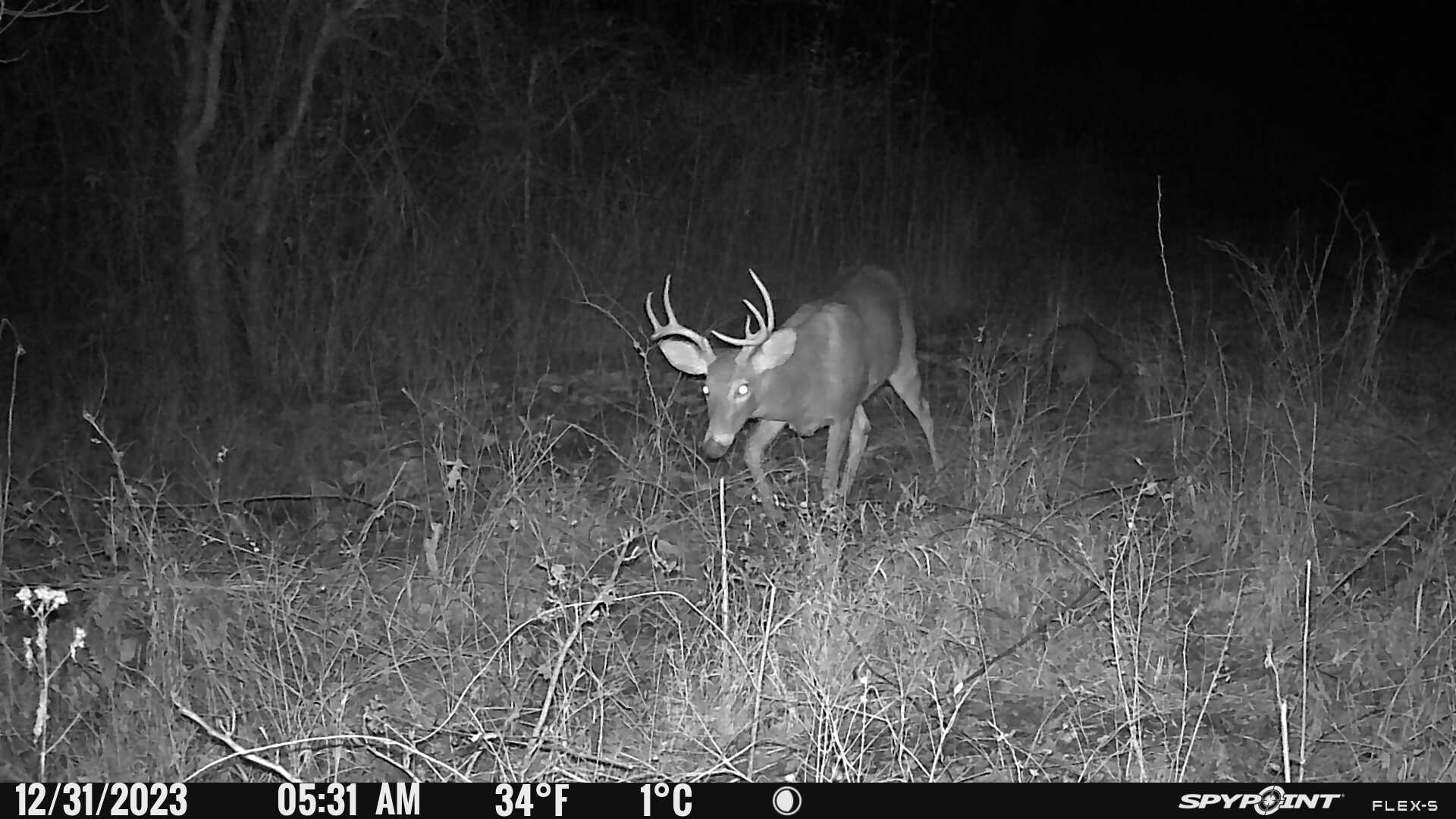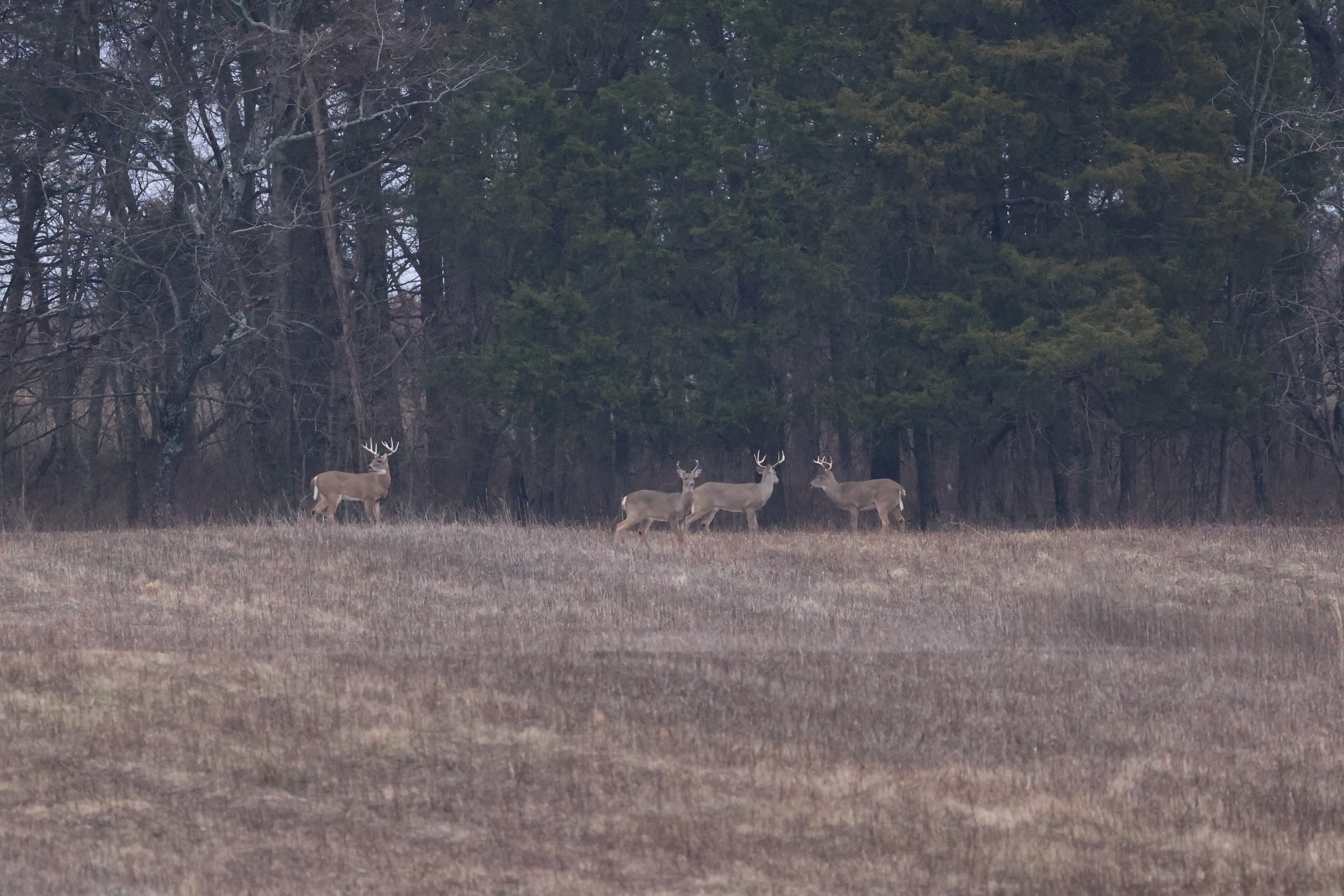
A heavy-racked, worn-down deer walks into a brassicas plot. It’s lost a lot of weight, and given the caution, it’s clearly seen hunting pressure this season. But you played your cards right, and that buck is headed home with you. Buck down. Tag filled. That’s a wrap.
Late-season deer are edgy, skittish, and difficult to hunt. Here are deer hunting tips for the late season.
1. Use the Right Gear
Late-season deer hunting can be quite difficult. Deer are pressured, and the elements are challenging. And both weather and temperature can make life difficult for deer hunters.
These factors require using optimal gear for the phase at hand. First, pair trail cameras with external battery sources. Maybe that’s a cell cam with an integrated solar panel. Perhaps it’s a traditional cell camera that’s synced with an external solar panel or battery box. These are important for overcoming cold weather temperatures, which can diminish camera battery life faster.
Of course, wear quality clothing. Cold, windy, rainy, snowy weather can be dangerous. At the very least, it can challenge a hunter’s resolve. Outfit yourself with hunting clothing and boots that protect you from the elements.
2. Locate Unpressured Pockets of Cover
By the arrival of the late season, most deer have received a lot of hunting pressure. Finding pressured pockets of cover that saw a few or no hunters earlier in the season can lead to some excellent late-season deer hunting.
Of course, expect older more mature bucks to have found these places. It’s these sanctuaries that you are most likely to find late-season bucks. And when you find one, expect to find other deer, too.
3. Find the Seasonal Bedding Areas
Deer needs change throughout the season. This is true for their betting area preferences, too. In winter, seasonal bedding cover comes in the form of solar and thermal bedding.
Solar bedding cover includes south-facing slopes, which receive the most sunlight in winter. Thermal bedding consists of a dense stand of conifers, such as cedars, spruces, or pines. The former allows them to experience more direct sunlight. The ladder holds more heat closer to the ground and shields them from wind and precipitation. Both help them make it through the winter.

4. Find the Seasonal Food Sources
Likewise, food sources are seasonal as well. Throughout the whitetail range, deer have been known to eat upward of 700 plant species. It’s impossible to name every plant that deer consume. That said, big-ticket items to focus on this time of year include crop fields with waste grain, crop fields with standing ag, cereal grain food plots, green food plots, remaining red oak acorns, woody browse, and more.
5. E-Scout, Glass from Afar, and Run Some Trail Cams
This who plan to hunt the late season stand to benefit from a good scouting plan. By now, deer are settling into consistent, reliable bed-to-feed patterns. A proper scouting plan can determine where these movements take place. Therefore, hunters should integrate a three-pronged effort, which includes e-scouting via apps and maps, glassing from afar, and running trail cameras.
6. Determine Lines of Movement
As alluded to above, bed-to-feed patterns become reliable deer activities that hunters can rely on. Determining the locations of these lines of movements provide hunters with excellent opportunities to set up ambush points. It creates a foundation for a tactical approach that helps level the playing field for deer hunters. Instead of guessing if deer are there, and what their movements might be, you know a great deal before the hunt begins.

7. Capitalize on Late-Rut Movement
To be clear, deer hunters shouldn’t rely on late-rut activity, especially during the late season. Most of said action is over, and isn’t a predictable event. It’s not an actionable tactic.
That said, a small minority of does are missed during their first cycle (and re-cycle 28 days later). More common, though, are doe fawns that enter estrus for the first time. Generally, a small percentage of doe fawns reach the necessary weight threshold to do so, and this rarely occurs before the late season.
Although hunters can’t rely on this, they can learn to recognize it. Additionally, they can understand how to capitalize on it. Know that doe fawns aren’t as cautious as adult does, and they are more likely to drag a big buck out into the open.
8. Wait for the Weather
Weather is very influential with deer movement. If the late-season weather and deer movement get stale, expect the next weather front to shake things up.
For example, if a front pushes through, and it brings snow, bank on daylight deer movement spiking. Even if it doesn’t snow, but produces bitter-cold temperatures, expect nearly the same. These are the moments to strike, move in, and hunt late-season target bucks.
9. Give Them the Wind
Late-season bucks have seen plenty of hunting pressure. Because of this, they’ll rarely bed without the wind in their favor. They’ll rarely move during daylight without a favorable wind, either.
For example, a deer might be in a bedding area to the east. It’s heading to a food source to the west. It’s a west wind, which puts the wind in the buck’s face as it moves toward its afternoon destination food source.
Hunting along its travel route is a just-off wind. The wind is technically in the buck’s favor, which encourages it to move earlier and further during daylight. That said, your stand location will be just off enough that it doesn’t enter your scent cone.
10. Take Important Precautions and Catch Deer Off Guard
By the late season, even the slightest mistake can ruin a hunt. It can even ruin your odds of tagging the buck the remainder of the season. Therefore, take important precautions to stay off the deer herd’s radar. Take good entry and exit routes. Follow good practices that can help you catch deer off guard.
Fill That Tag
The late season is an excellent time to tag a big deer. Mature whitetails are more educated than ever before, but they’re slaves to their stomachs, and the late season produces some of the most reliable bed-to-feed deer movements. If you’re still carrying a tag, work diligently to cash it in during the late season.



